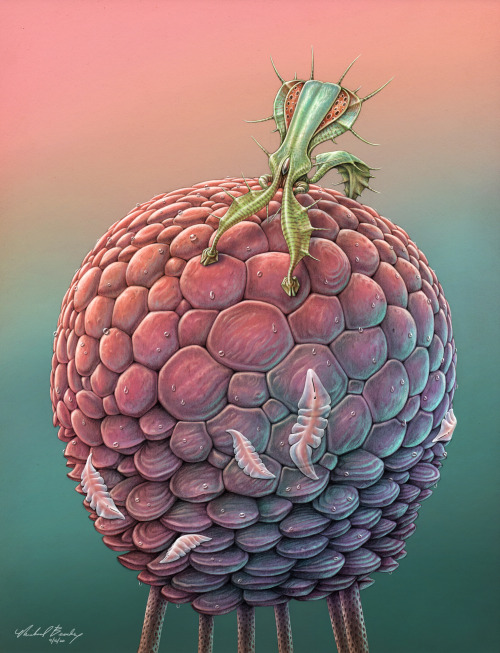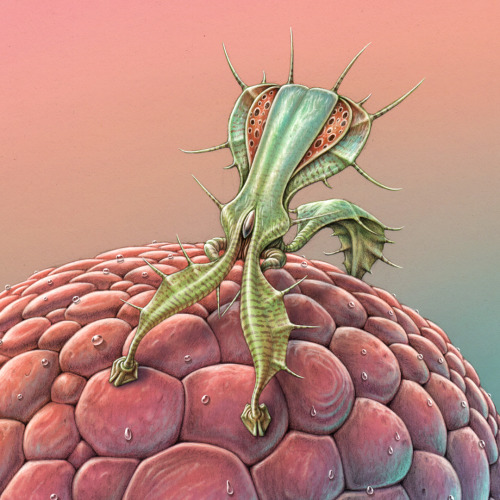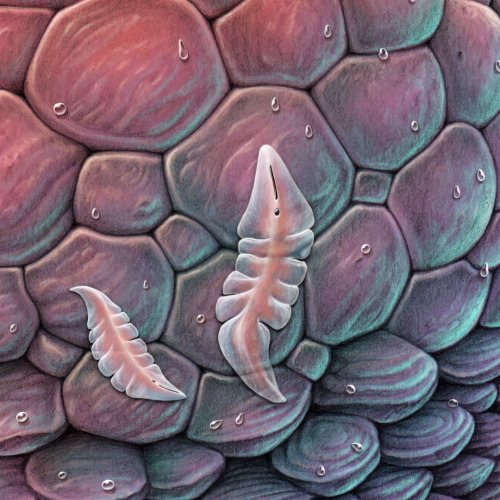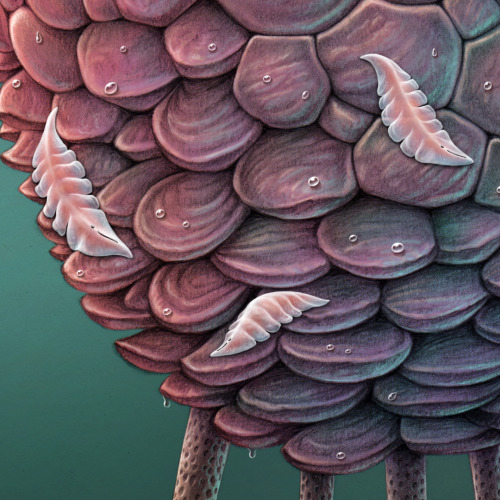A New Environment With Some New Species Here.

A new environment with some new species here.
This is the first look into this particular biome- hopefully with more to come. All creatures depicted have a photosynthetic component to them - least of all the large plodding walkers, who rely most heavily on grazing for their energy intake. The creatures that resemble flowers are motile, but move less frequently. The long rope-like organism grows at a rapid pace to stake its claim over as much ground area as possible. The large round textures semi-spheres are not phased by this tactic, as they employ an electro-chemical defense over their outer surface to keep the strident ropes at bay.
More Posts from Exobiotica and Others

A common site in these dry rocky areas is the Velumignus. Their immobile bases send tendrils deep underground in search of water, while the photosynthetic flattened upper portions can swivel to accommodate for light and wind direction. Reaching a height of over fifteen feet, these silent sun-catchers often serve as way-finding posts to creatures journeying through the High Desert.




Here is a nocturnal view of a habitat in which the inhabitants have evolved extreme forms of bioluminescence. The vertical glowing blobs are the reproductive bulb form of a species with a complex life cycle (to be elucidated in following artworks). The groove-backed, ravenous creatures at the bottom are of the same species as the glowing blobs, but at a different life stage. At center is a rather placid, slow-moving consumer of the bulbs- one who has incorporated its own form of bioluminescence into its respiratory apparatus as a means of camouflage. Names and descriptions will come as soon as possible.




Kings of the High Desert
A herd of strange creatures has congregated on this rocky outcrop. Known as Emperor Shinebacks, they often climb these rugged foothills to obtain access to cooling breezes and additional food sources. Their top-heavy tripodal stature prevents further ascension into the mountains, but it serves them well on more level ground. Reflective carapaces mitigate much of the sun’s harmful rays, and cooling flaps along their flanks dissipate excess heat. A shineback’s normal gait is rather clumsy, but when haste is needed they clamp all three legs together into a single monopod and bounce effortlessly across the desert at remarkably high speeds. This combined with their massive size (adults are over eight feet tall) and protective social behavior makes them almost impervious to attack. Almost…






The Garden of Unearthly Delights
Biodiversity in Glow Forest Communities
Down on the floor of the Glow Forest, a startling array of lifeforms has evolved in the cool dark mist. The creatures that comprise the main structure of this biome are known as Vela, and they stretch skyward, consuming all the available sunlight and allowing none to escape below. This species won an evolutionary arms race long ago, and as a result its photosynthetic competitors were pushed to extinction. However being a successful monoculture has its disadvantages. Autotrophs form the base of the food chain in most environments, and now the Vela is the only one. This means it is now the main food source for many other species who would otherwise have more choices. Its main nemesis is the Stragulum. This amorphous creeping wrinkled blanket infects a new Vela pseudopod nearly as soon as it touches the ground. It rapidly takes hold and covers every inch of the surface, slowly digesting it. This in turn attracts a cadre of new organisms which consume the flesh of the Stragulum. Predators are then drawn to the area, and as the number of species grows, a self-perpetuating cycle of increasing biodiversity takes place. Eventually, the Stragulum becomes too much of a burden to the Vela and it severs its pseudopod in order to rapidly grow another nearby. But the biomass of the parasite still lingers for quite some time, feeding a plethora of bizarre and unique organisms scrambling for their share of the resources in this oasis of light amidst the darkness.

Early India ink painting of an aquatic predator. (Un-named)






Codependence
Natural selection breeds competition, but it can also lead to sophisticated cooperation. The Glass Colligatio is what is known as a composite organism—a creature comprised of members of multiple species that share critical biological processes between them. The larger swimmer provides mobility, while its multi-legged symbiont feeds more efficiently than it could alone. Through the interspecies junction—a specialized dual orifice connecting the creatures—they share nutrients and oxygen, each specializing in what it does best while providing for the needs of the whole.




Guardian
On Veteris, it is common for creatures to obtain energy from multiple sources. The large round, multifaceted autotroph angles its plates to face the light at any given time of day. It also feeds on decomposing organic matter it obtains by moving slowly on its long spindly legs. Conversely, the spiny guardian on top originally evolved to hunt the semi-transparent flat creatures that feed on the autotroph, but came to rely on them exclusively. Over many generations, individuals that allowed some prey items to live and reproduce eventually outlasted the more aggressive hunters, and now their style of subsistence is closer to farming. The guardians now protect the entire micro-system – each large round walker and its flock of parasites is topped by a spiny guardian who has the dual task of defending against predators as well as keeping the herd numbers in check. A round walker without a guardian slowly succumbs to parasite overpopulation. Occasionally huge numbers of walkers congregate in vast gently-swaying miniature forests, each crowned by a flamboyant spiny guardian defending its small world.






In the waters of a lowland swamp, a dramatic scene unfolds in miniature. The skeletal remains of a long-deceased creature have been colonized by a gelatinous, rather fluffy organism known as Rugosa. Covering any available real estate like a crumpled, spreading blanket, this filter feeder removes organic particulates from the surrounding water. Swamps with high levels of Rugosa growth maintain a more transparent water column, hosting more autotrophs and greater biodiversity. Firmly attached to this ensconced matrix is the decaying husk of a once mobile Flame Diversoma. Its last dying act was to serve as a shelter for its numerous offspring, which are now developed enough to disperse en masse. The coordinated timing of this exodus is critical, for a slow diffusion of these larvae would make them easy prey for the surrounding cadre of predators, who have gathered in anticipation of this event. The most successful hunter thus far is the Spotted Spearmouth, which relies on its harpoon-like proboscis to stab the passing swimmers and drag them into its maw. A vast swarm of semi-transparent Swamp Pearls paddles along slowly, unaware of the violence unfolding nearby. Having little in the way of visual sensors or situational awareness, their lives are consumed by chasing the flow of nutrients and favorable conditions in this tangled aquatic realm.
I like your art. It is such a beautiful place and I can see Veteris being a wonderful place to explore in your art and world.
Thank you! I have a world full of ideas to bring to life, it just takes a long time.
-
 verins-little-notebook liked this · 8 months ago
verins-little-notebook liked this · 8 months ago -
 jayjayzzzzzz liked this · 1 year ago
jayjayzzzzzz liked this · 1 year ago -
 wtrotsky-blog liked this · 1 year ago
wtrotsky-blog liked this · 1 year ago -
 spiffyspidr liked this · 2 years ago
spiffyspidr liked this · 2 years ago -
 scientificallyaccuratedragon reblogged this · 2 years ago
scientificallyaccuratedragon reblogged this · 2 years ago -
 walkingmybird liked this · 2 years ago
walkingmybird liked this · 2 years ago -
 skullsulker liked this · 2 years ago
skullsulker liked this · 2 years ago -
 lastoutter liked this · 2 years ago
lastoutter liked this · 2 years ago -
 shitou456 liked this · 3 years ago
shitou456 liked this · 3 years ago -
 crusty liked this · 3 years ago
crusty liked this · 3 years ago -
 sinnersinsuits liked this · 3 years ago
sinnersinsuits liked this · 3 years ago -
 theskyrabbit liked this · 3 years ago
theskyrabbit liked this · 3 years ago -
 aphid-kirby liked this · 3 years ago
aphid-kirby liked this · 3 years ago -
 squirrel-stars liked this · 3 years ago
squirrel-stars liked this · 3 years ago -
 annoyingalchemist liked this · 3 years ago
annoyingalchemist liked this · 3 years ago -
 ferncube liked this · 3 years ago
ferncube liked this · 3 years ago -
 spiderlingbriary reblogged this · 3 years ago
spiderlingbriary reblogged this · 3 years ago -
 spiderlingbriary liked this · 3 years ago
spiderlingbriary liked this · 3 years ago -
 ya-boy-husk liked this · 4 years ago
ya-boy-husk liked this · 4 years ago -
 red-red-spout liked this · 4 years ago
red-red-spout liked this · 4 years ago -
 craebe liked this · 4 years ago
craebe liked this · 4 years ago -
 captaincoombs liked this · 4 years ago
captaincoombs liked this · 4 years ago -
 salmonofwisdom liked this · 4 years ago
salmonofwisdom liked this · 4 years ago -
 penumbra51302 liked this · 4 years ago
penumbra51302 liked this · 4 years ago -
 metalzoic liked this · 4 years ago
metalzoic liked this · 4 years ago -
 aralking liked this · 5 years ago
aralking liked this · 5 years ago -
 funky-insanitear liked this · 5 years ago
funky-insanitear liked this · 5 years ago -
 creaturedeityendless liked this · 6 years ago
creaturedeityendless liked this · 6 years ago -
 1111x47 reblogged this · 6 years ago
1111x47 reblogged this · 6 years ago -
 pmmdj liked this · 6 years ago
pmmdj liked this · 6 years ago -
 chronivore reblogged this · 6 years ago
chronivore reblogged this · 6 years ago -
 hiddenlizard liked this · 6 years ago
hiddenlizard liked this · 6 years ago -
 sunshynegrll reblogged this · 6 years ago
sunshynegrll reblogged this · 6 years ago -
 stormsmadderthanhell69smut4vr reblogged this · 6 years ago
stormsmadderthanhell69smut4vr reblogged this · 6 years ago -
 spaceraptor reblogged this · 6 years ago
spaceraptor reblogged this · 6 years ago -
 spaceraptor liked this · 6 years ago
spaceraptor liked this · 6 years ago -
 cubeofannihilation reblogged this · 6 years ago
cubeofannihilation reblogged this · 6 years ago -
 cubeofannihilation liked this · 6 years ago
cubeofannihilation liked this · 6 years ago -
 flei-the-chaos-dragon reblogged this · 6 years ago
flei-the-chaos-dragon reblogged this · 6 years ago -
 lil-tachyon liked this · 6 years ago
lil-tachyon liked this · 6 years ago -
 diskoouija liked this · 6 years ago
diskoouija liked this · 6 years ago -
 nefalen reblogged this · 6 years ago
nefalen reblogged this · 6 years ago -
 nefalen liked this · 6 years ago
nefalen liked this · 6 years ago -
 opalescent-yams-blog reblogged this · 6 years ago
opalescent-yams-blog reblogged this · 6 years ago -
 opalescent-yams-blog liked this · 6 years ago
opalescent-yams-blog liked this · 6 years ago -
 siryl reblogged this · 6 years ago
siryl reblogged this · 6 years ago



